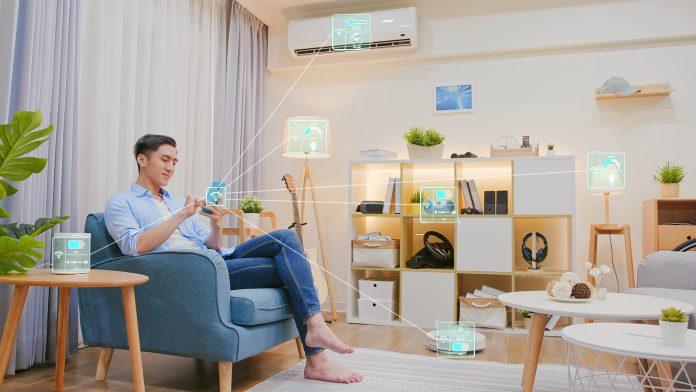Smart home technology can transform the experience of living at home. Smart devices help consumers meet their sustainability goals while making life more comfortable. Research demonstrates the significance of effort expectancy (EE) and perceived usefulness (PU) when it comes to consumer attitudes towards smart home technologies. But there is limited research that looks at how individual perceptions intersect with societal norms and peer influence.
1. I Want to Know What’s Going on
Imagine living in a smart home that adapts to your individual needs and preferences, from automatic coffee brewing at set times to turning down the thermostat before arriving home or notifying you of unexpected visitors – not science fiction but now possible thanks to new smart home systems.
Select an ecosystem that complements your lifestyle and facilitates seamless integration. When searching for devices to support Matter (an open standard designed to provide cross-brand compatibility; more on this later), begin with security and energy efficiency devices, as these can have immediate effects on comfort and utility costs.
2. I Want to Control Everything
Imagine living in a home where every aspect can be managed with just the touch of an app or voice command – this is the reality brought about by smart technology. Imagine having a smart slow cooker that sends notifications when it’s time to eat or an oven that preheats on its way home so dinner will be ready when you arrive home – these devices are revolutionizing kitchen life and offering unprecedented levels of freedom.
Many smart technologies are connected to the cloud, providing remote access regardless of your location or smartphone connectivity. This helps ensure that your home remains secure whether you’re away on vacation or working at the office.
3. I Want to Save Money
Smart devices can be an excellent way to save energy, money, and the environment. A smart thermostat uses sensors to detect when you are home or away and learn your daily routines so it can adjust temperature based on that information.
Smart energy monitors can assist in monitoring power usage and optimizing usage by shifting high-consuming appliances to run during cheaper tariff periods. Since energy prices and climate reports can fluctuate quickly, consumers want to ensure they get value for their money; smart tech should make this process as seamless as possible.
4. I Want to Stay Connected
Smart devices make staying connected easy. From home assistants like Amazon Alexa or Google Assistant to streaming media devices like Apple TV and Roku, these gadgets make staying in touch easier than ever by providing access to on-demand content and communication options via voice call or app.
Other technologies are increasing home connectivity, such as smart doorbells that enable homeowners to converse with visitors from any location and video cameras that stream live action. Smart light bulbs and energy-saving plugs also monitor occupancy status to adjust lighting automatically, thus increasing home connectivity further.
Assess your device ecosystems, and select platforms that support Matter, the new smart home standard designed to overcome compatibility issues (Build With Matter). Furthermore, ensure strong Wi-Fi coverage throughout your home so as to avoid dead spots.
5. I Want to Make My Life Easier
Smart home technology streamlines household chores, offers valuable insights, and provides long-term convenience and benefits. In addition to making homes more energy efficient and cost-effective while improving comfort and security. Smart thermostats track your daily activities and adapt themselves to fit into your routine, while smart lighting systems can sense when an alarm goes off or adjust to suit your level of brightness preference.
Future technologies could allow you to control devices using voice command or remotely via phone and without dealing with cumbersome wired charging cables tangled around them. As wireless smart home gadgets gain in popularity, such advancements could soon become reality.
6. I Want to Stay Healthy
Smart homes provide residents with an easy way to monitor and tailor their experience according to individual preferences, such as starting the washing machine and turning on the fireplace before they arrive home; temperature adjustments can also be made depending on who comes and goes from their smart home.
Smart health devices assist users in staying healthy by tracking activities and sending daily reports to loved ones or emergency services in case the wearer experiences a fall or sudden heart rate changes. These wearable heart monitors can send immediate alerts in case a user experiences sudden changes, for example, in heart rate fluctuations or falls.
Other devices assist people in sleeping better by restricting smartphone usage before bedtime, which can inhibit melatonin production and interfere with quality rest. Meanwhile, innovators have devised smart paint, which functions both as an electronic sensor and a touchscreen surface.
7. I Want to Be More Organized
Being organized means more than simply clearing away clutter in your inbox and clearing away paperwork from your desk – it means creating an efficient system that supports your long-term goals and works towards meeting them with maximum effectiveness.
Smart home technology now makes life simpler for us all by giving people control over their homes through voice or touch control devices. These devices aim to streamline household chores, provide insights, reduce cost and energy efficiency, and deliver long-term benefits to users.
Smart home solutions enable seamless control via cloud workflows that automate multiple tasks that fit seamlessly with your lifestyle and reduce stress while creating an individualized experience for you.
8. I Want to Be More Creative
Creativity is like a muscle, and exercising it regularly is key for its well-being. Smart home technology enables this opportunity. Making use of the cloud to create workflows that adjust ambient lighting based on time of day or switch the TV channel automatically are two exciting new possibilities.
Another smart home technology trend involves wirelessly charging devices. Just ensure you have enough Wi-Fi coverage throughout your home to avoid dead spots from interfering with performance; this will be key in ensuring the success of your smart home network.



